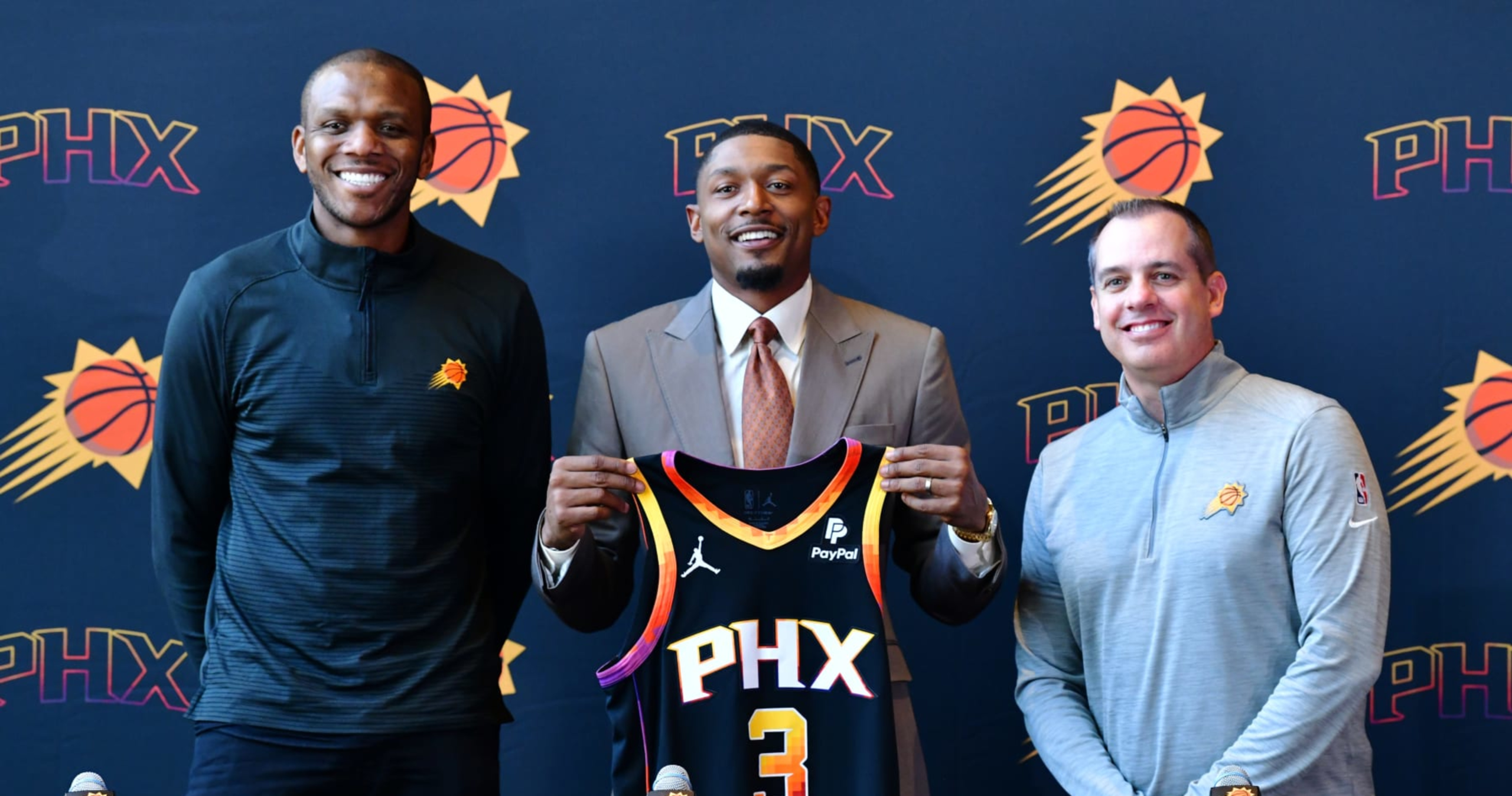Sports
Predicting the NBA's Worst Contracts Next Season – Bleacher Report

The NBA economy is constantly evolving.
Just ask Boston Celtics swingman Jaylen Brown, who just agreed to the richest contract in league history. Including the money remaining on his current deal, he’s set to collect a whopping $332.2 million over the next six seasons.
That’s a huge chunk of change for someone who isn’t universally regarded as a top-10 talent.
If it is an overpay, though, it still isn’t anywhere near the following five contracts, which look like the league’s worst deals—ranked on everything from a player’s ability and availability to their age and the length of their remaining contract—heading into the 2023-24 campaign.
Back in Aug. 2021, the Chicago Bulls made a four-year, $85 million commitment to Lonzo Ball as part of a sign-and-trade deal with the New Orleans Pelicans. The floor general has suited up just 35 times, and it’s unclear when (or, gulp, if) he’ll hit the hardwood next.
He hasn’t played since suffering a knee injury in Jan. 2022, undergoing three surgical procedures along the way. The Bulls, who spent the entire 2022-23 campaign without him, have already announced they expect he’ll miss the 2023-24 season, too.
For some, that might be reason enough to rank Ball atop this list. Here’s why I didn’t.
The Bulls “have some insurance” on the contract in case Ball never suits up again, per NBC Sports Chicago’s K.C. Johnson. They also requested and were granted a disabled player exception for $10.2 million. That means the damage done by his deal—in both actual cost and cap flexibility—isn’t quite as devastating as it seems.
Plus, it’s worth noting a healthy Ball would collect a salary at least this rich if he hit the open market. He is 25 years old, a two-way playmaker and easy to fit on almost any roster since he can operate on or off the ball. His teams have always fared better with him than without.
While there is an argument to include him on this list, it just didn’t seem to fit the spirit of the exercise.
Age: 27
Remaining Contract: Five years, $270.6 million (player option for final season)
The way Karl-Anthony Towns sees it, he’s a game-changing talent who has already left an indelible mark on the sport of basketball. In reality, he’s a one-way player who has never impacted winning the way his numbers would make you think.
The 27-year-old might be the best shooting big man of all time, and he has an impressive array of scoring skills and slick passes for a player his size (6’11”, 248 lbs). But he is also an incredibly limited defender who has yet to advance past the opening round of the playoffs and is finding it increasingly difficult to shake the injury bug.
Towns has played more than 50 games just once in the past four seasons. In two of them, he suited up 35 times or less. Since arriving as the top pick of the 2015 draft, he has piloted the Minnesota Timberwolves to a 273-355 record. That’s the sixth-worst winning percentage over this stretch.
He has been the best player on bad teams and the second-best on mediocre ones. What about his resume—other than some enticing per-game averages—would make anyone want to pay him an average annual salary north of $54 million into his 30s?
Between the pay rate, the recent availability issues and the limited impact on winning, that was enough to slot him in the fifth spot and spare some of the other candidates—like Damian Lillard, Michael Porter Jr. and Jordan Poole—this dubious distinction.
Age: 31
Remaining Contract: Three years, $131.5 million (player option on final season)
It’s usually pretty tricky to boil any NBA player’s season down to a single word, but Rudy Gobert’s first go-round in the Gopher State was one of the exceptions.
Unfortunately for him and the Timberwolves—who paid an eye-gouging price to get him—the word to sum up his season was simple: Yikes.
Everything about it was rough, and that went far beyond the typical growing pains of a team adjusting on the fly. Minnesota, which won four fewer games than it did the season before its all-in trade, struggled in ways that won’t be easily fixed.
None of this bodes well for Gobert’s chances of living up to this costly contract as he advances deeper into his 30s. He was arguably overpaid all along, since he is functionally a defensive specialist, but now he is egregiously so, since his defense is no longer special. He didn’t even crack the top 50 in FiveThirtyEight’s Defensive RAPTOR.
He isn’t the nimblest mover, so teams have had success forcing him to guard on the perimeter. That will only get more challenging as he gets older. The hope is he can offset that limitation by dominating the interior. That simply didn’t happen this past season. He saw big dips in field-goal shooting (71.3 to 65.9), rebounds (14.7 to 11.6) and blocks (2.1 to 1.4). Meanwhile, his shooting percentage allowed at the rim climbed nearly 10 points (49.3 to 58.1).
He is quite possibly already declining, but his salary isn’t. He’s set to collect $41 million this season and $43.8 million the next. His $46.7 million salary for 2025-26—his age-33 season—is technically a player option, but the odds of him declining it are worse than one of us pulling in Powerball’s next jackpot prize.
Age: 29
Remaining Contract: Three years, $57.4 million
If you tracked the Heat’s run to the NBA Finals, you may have caught wind of Duncan Robinson’s redemption story.
While it’s true the sharpshooter played his best basketball of the season on the sport’s biggest stage, the spotlight took things out of proportion. The story wasn’t about him ascending to new heights, but rather somewhat finding his way out of a precipitous fall. You just can’t find many other instances of a near-$20 million player being praised for averaging 9.0 points over 23 outings.
The redemption tale was merely about the 29-year-old being unplayable to sort of usable in a part-time, reserve role. Credit him for not losing his composure when he lost his roster spot, but Miami had reasons for routinely passing him over in the regular season. It’s hard to play a shooting specialist who forgot how to shoot (32.8 three-point percentage over 42 regular-season contests).
The Heat initially hurt themselves by overspending on a one-note player. In May 2021, they gave Robinson a five-year, $90 million pact, at the time the richest contract ever rewarded to an undrafted player. He started regressing almost immediately, and shortly thereafter, his deal was being regarded as one of basketball’s worst.
“You can argue that, for its length, he has the worst contract in the league,” an Eastern Conference executive told Heavy.com’s Sean Deveney in Dec. 2022. “… The Heat have him signed through 2026, and you just do not know what level he is going to be able to help you at from here on. He has been really bad as a shooter, and we know he can’t defend, so what is he bringing to the table?”
While Robinson’s average annual salary is by far the smallest on these rankings, the fact that his floor drops down to unplayable territory makes him a lock for the top three. The Heat have booted him from the rotation before, and they might have to do so again down the line—all while paying him almost $20 million per season. Ouch.
Age: 27
Remaining Contract: Two years, $78.2 million
It’s tempting to drown yourself in offseason optimism and believe this will be the time when Ben Simmons finally gets back on track.
But would you bet $78.2 million on that happening? Of course not.
He has looked broken since his disastrous playoff run with the Philadelphia 76ers in 2021. He seemingly lost all confidence in that series—most memorably passing up a potential dunk on a possession the Sixers had to have—and it may have pushed him past the point of no return.
Simmons missed the entire 2021-22 season due to a holdout and a back injury. He played 42 games this past season but appeared nowhere close to his previous form. Virtually his entire stat sheet dipped to career-low levels, including his first below-average player efficiency rating (13.4) and a win share count that was barely a third of his previous worst (2.2).
As a 27-year-old, he should be in the heart of his prime. He appears to be racing through one of the league’s swiftest declines instead. He is unreliable in all aspects—he’s missed two full seasons to injuries and last topped 60 games in 2018-19—and if his athleticism doesn’t return, he could struggle to find his NBA niche.
He has time to turn things around, of course, but if you’re looking for any evidence of that happening, you won’t find it. The best thing about his contract is that it only has two seasons remaining.
With such little production to show for such a big pay rate, though, the time left on the deal merely spares Simmons from landing in the top spot.
Age: 30
Remaining Contract: Four years, $207.7 million (player option on final season, no-trade clause)
Bradley Beal is a good player. He just happens to be paid as if he’s one of the game’s greatest and will continue being compensated as such into his mid-30s.
Moving over to the Suns should add some significance to his stats that never materialized over his 11-year tenure with the Washington Wizards. He rarely made playoff noise in the District; next season, he could have a substantial impact on the championship race.
Of course, the reason Beal’s in the title race now is because he is properly placed on a franchise hierarchy for the first time. He won’t be the Suns’ primary or secondary option; Kevin Durant and Devin Booker will handle those roles. He will, however, be paid like a superstar tasked with guiding an entire organization.
The money owed to the 30-year-old—plus the no-trade clause inexplicably given to him—is the reason why the Suns plucked him out of Washington for almost nothing: a past-his-prime Chris Paul, a never-in-his-prime Landry Shamet and a batch of second-round picks and first-round pick swaps.
A player making this much should be borderline perfect. Beal is far from that. He’s a good scorer, but not always the most efficient one. He is a capable creator, but not someone you want initiating your offense. He used to be an adequate defender, but he’s been a net negative on that end for some time.
Oh, he also has a host of injury concerns, having last topped 60 games in 2018-19, and maybe those could worsen with age.
As a player, he is fun to watch and could be more fun than ever in Phoenix. As far as his contract is concerned, though, it’s as bad as they come entering the 2023-24 campaign.
Statistics courtesy of Basketball Reference and NBA.com.
Zach Buckley covers the NBA for Bleacher Report. Follow him on Twitter, @ZachBuckleyNBA.









